Operations Management and Quality Improvement Strategies: Toys Ltd.
VerifiedAdded on 2023/04/22
|8
|2155
|110
Report
AI Summary
This report examines the operational challenges faced by Toys Ltd., a toy manufacturer in Cyprus, focusing on declining profitability due to increasing competition and returns of defective goods. The analysis identifies key issues such as economic pressures and ineffective quality control measures. Recommendations include implementing stringent end-line inspections, fostering better communication between quality control and operations teams, and adopting cost-effective production methods without compromising product quality. Strategies for addressing defective goods returns, such as innovative product development and efficient resource utilization, are also proposed. The report emphasizes the importance of continuous improvement in quality management and cost control to restore profitability and maintain a positive brand image for Toys Ltd. By utilizing total quality management tools, investing in capital equipment, and providing specialized employee training, Toys Ltd. can enhance its operational efficiency and product quality, ensuring long-term sustainability and competitiveness in the market. This document is available on Desklib, a platform offering study tools and solved assignments for students.
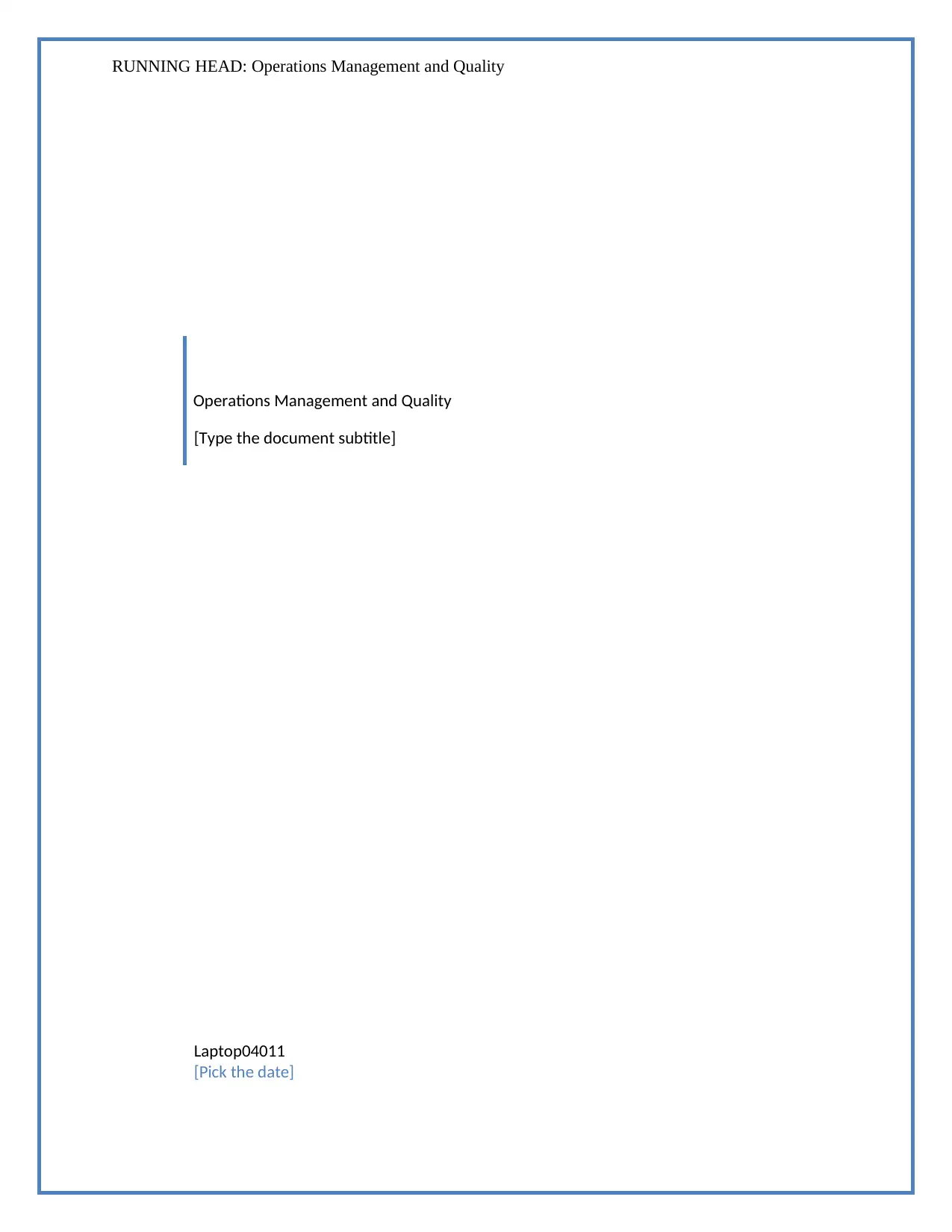
RUNNING HEAD: Operations Management and Quality
Operations Management and Quality
[Type the document subtitle]
Laptop04011
[Pick the date]
Operations Management and Quality
[Type the document subtitle]
Laptop04011
[Pick the date]
Paraphrase This Document
Need a fresh take? Get an instant paraphrase of this document with our AI Paraphraser
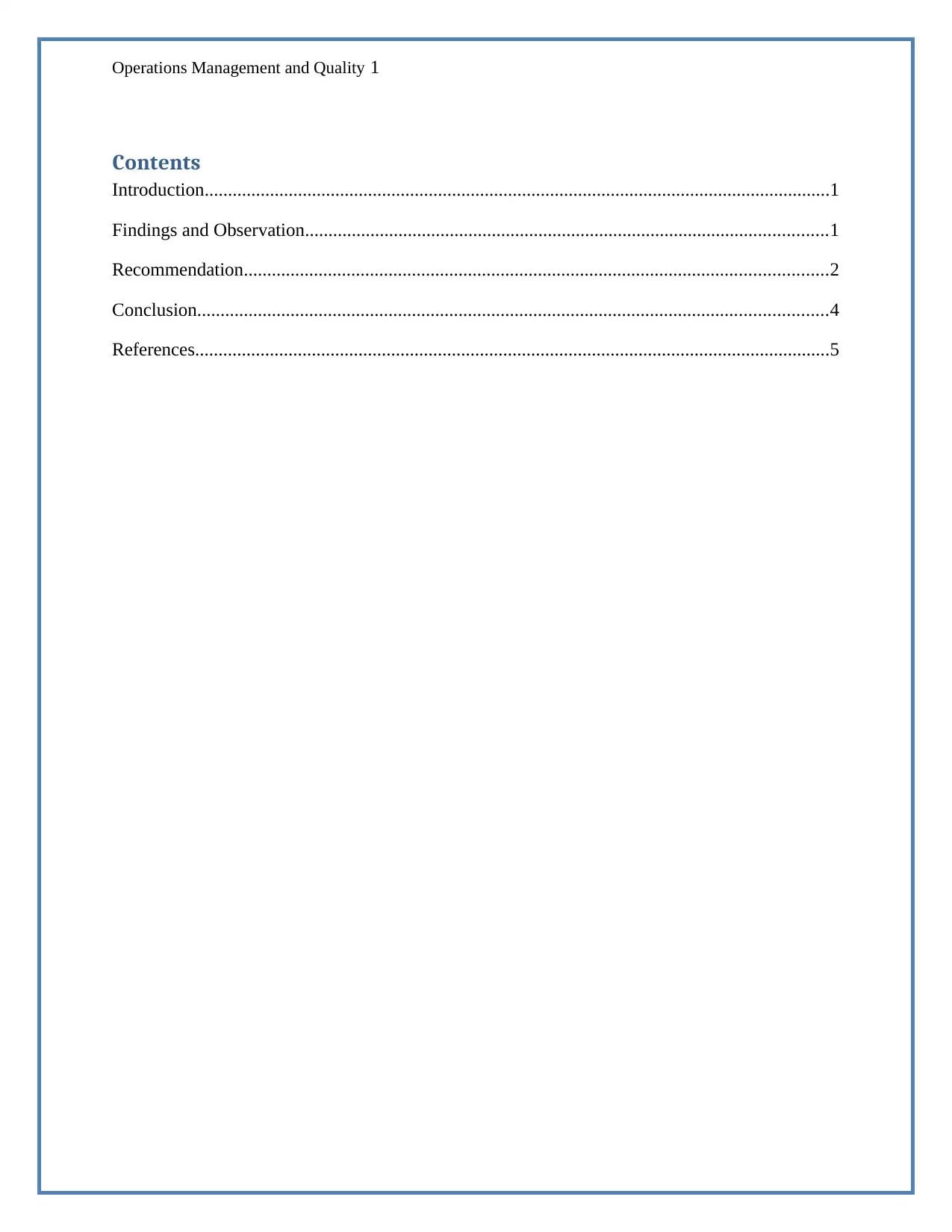
Operations Management and Quality 1
Contents
Introduction......................................................................................................................................1
Findings and Observation................................................................................................................1
Recommendation.............................................................................................................................2
Conclusion.......................................................................................................................................4
References........................................................................................................................................5
Contents
Introduction......................................................................................................................................1
Findings and Observation................................................................................................................1
Recommendation.............................................................................................................................2
Conclusion.......................................................................................................................................4
References........................................................................................................................................5
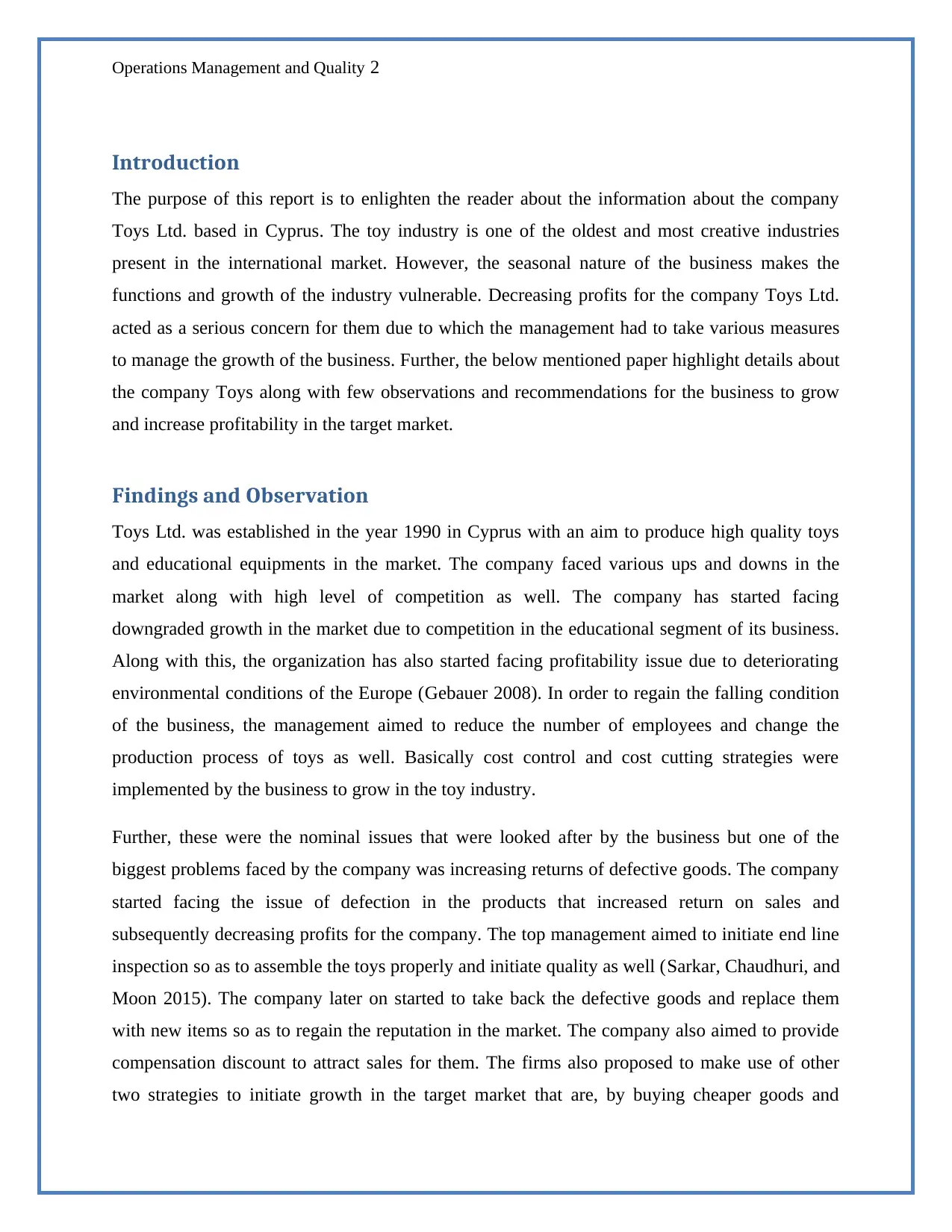
Operations Management and Quality 2
Introduction
The purpose of this report is to enlighten the reader about the information about the company
Toys Ltd. based in Cyprus. The toy industry is one of the oldest and most creative industries
present in the international market. However, the seasonal nature of the business makes the
functions and growth of the industry vulnerable. Decreasing profits for the company Toys Ltd.
acted as a serious concern for them due to which the management had to take various measures
to manage the growth of the business. Further, the below mentioned paper highlight details about
the company Toys along with few observations and recommendations for the business to grow
and increase profitability in the target market.
Findings and Observation
Toys Ltd. was established in the year 1990 in Cyprus with an aim to produce high quality toys
and educational equipments in the market. The company faced various ups and downs in the
market along with high level of competition as well. The company has started facing
downgraded growth in the market due to competition in the educational segment of its business.
Along with this, the organization has also started facing profitability issue due to deteriorating
environmental conditions of the Europe (Gebauer 2008). In order to regain the falling condition
of the business, the management aimed to reduce the number of employees and change the
production process of toys as well. Basically cost control and cost cutting strategies were
implemented by the business to grow in the toy industry.
Further, these were the nominal issues that were looked after by the business but one of the
biggest problems faced by the company was increasing returns of defective goods. The company
started facing the issue of defection in the products that increased return on sales and
subsequently decreasing profits for the company. The top management aimed to initiate end line
inspection so as to assemble the toys properly and initiate quality as well (Sarkar, Chaudhuri, and
Moon 2015). The company later on started to take back the defective goods and replace them
with new items so as to regain the reputation in the market. The company also aimed to provide
compensation discount to attract sales for them. The firms also proposed to make use of other
two strategies to initiate growth in the target market that are, by buying cheaper goods and
Introduction
The purpose of this report is to enlighten the reader about the information about the company
Toys Ltd. based in Cyprus. The toy industry is one of the oldest and most creative industries
present in the international market. However, the seasonal nature of the business makes the
functions and growth of the industry vulnerable. Decreasing profits for the company Toys Ltd.
acted as a serious concern for them due to which the management had to take various measures
to manage the growth of the business. Further, the below mentioned paper highlight details about
the company Toys along with few observations and recommendations for the business to grow
and increase profitability in the target market.
Findings and Observation
Toys Ltd. was established in the year 1990 in Cyprus with an aim to produce high quality toys
and educational equipments in the market. The company faced various ups and downs in the
market along with high level of competition as well. The company has started facing
downgraded growth in the market due to competition in the educational segment of its business.
Along with this, the organization has also started facing profitability issue due to deteriorating
environmental conditions of the Europe (Gebauer 2008). In order to regain the falling condition
of the business, the management aimed to reduce the number of employees and change the
production process of toys as well. Basically cost control and cost cutting strategies were
implemented by the business to grow in the toy industry.
Further, these were the nominal issues that were looked after by the business but one of the
biggest problems faced by the company was increasing returns of defective goods. The company
started facing the issue of defection in the products that increased return on sales and
subsequently decreasing profits for the company. The top management aimed to initiate end line
inspection so as to assemble the toys properly and initiate quality as well (Sarkar, Chaudhuri, and
Moon 2015). The company later on started to take back the defective goods and replace them
with new items so as to regain the reputation in the market. The company also aimed to provide
compensation discount to attract sales for them. The firms also proposed to make use of other
two strategies to initiate growth in the target market that are, by buying cheaper goods and
⊘ This is a preview!⊘
Do you want full access?
Subscribe today to unlock all pages.

Trusted by 1+ million students worldwide
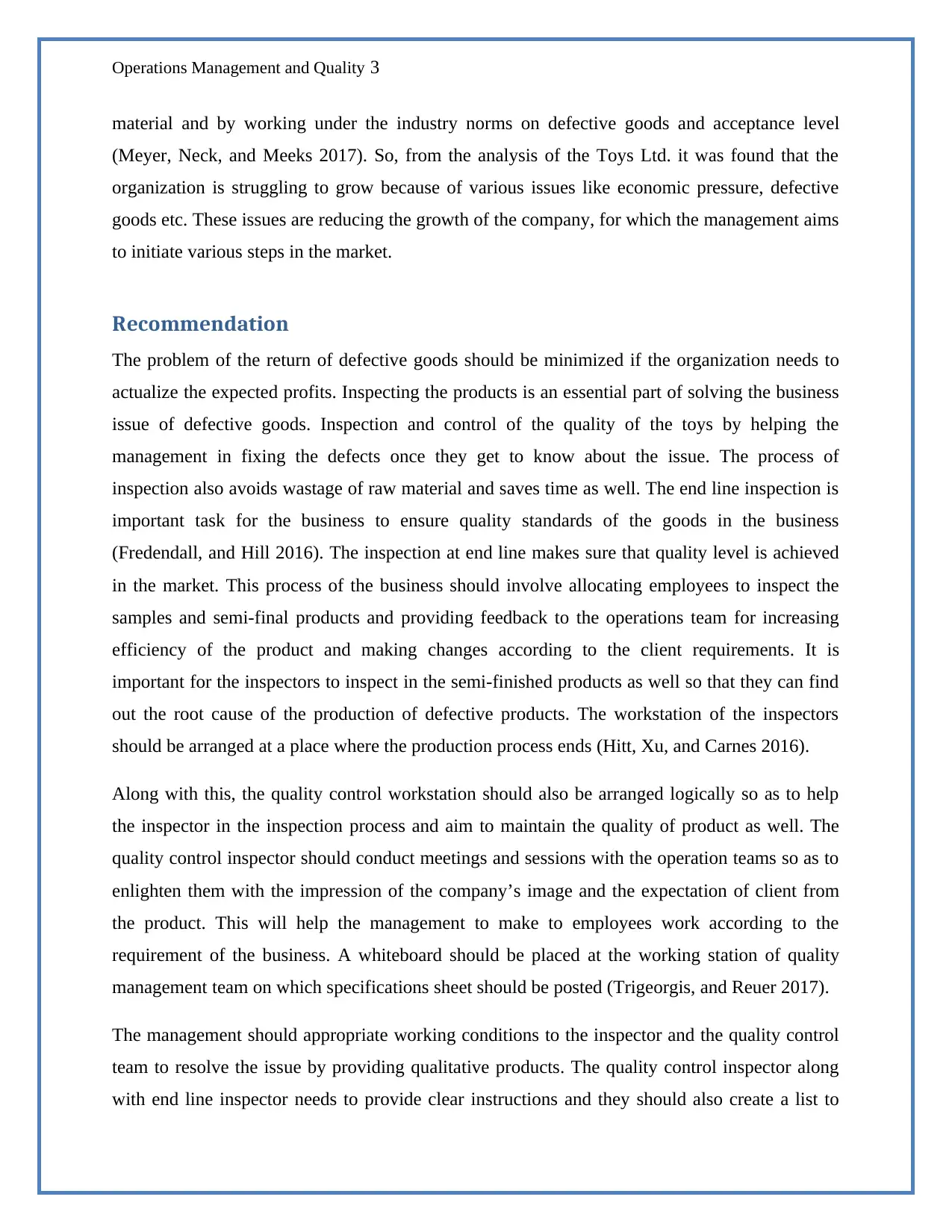
Operations Management and Quality 3
material and by working under the industry norms on defective goods and acceptance level
(Meyer, Neck, and Meeks 2017). So, from the analysis of the Toys Ltd. it was found that the
organization is struggling to grow because of various issues like economic pressure, defective
goods etc. These issues are reducing the growth of the company, for which the management aims
to initiate various steps in the market.
Recommendation
The problem of the return of defective goods should be minimized if the organization needs to
actualize the expected profits. Inspecting the products is an essential part of solving the business
issue of defective goods. Inspection and control of the quality of the toys by helping the
management in fixing the defects once they get to know about the issue. The process of
inspection also avoids wastage of raw material and saves time as well. The end line inspection is
important task for the business to ensure quality standards of the goods in the business
(Fredendall, and Hill 2016). The inspection at end line makes sure that quality level is achieved
in the market. This process of the business should involve allocating employees to inspect the
samples and semi-final products and providing feedback to the operations team for increasing
efficiency of the product and making changes according to the client requirements. It is
important for the inspectors to inspect in the semi-finished products as well so that they can find
out the root cause of the production of defective products. The workstation of the inspectors
should be arranged at a place where the production process ends (Hitt, Xu, and Carnes 2016).
Along with this, the quality control workstation should also be arranged logically so as to help
the inspector in the inspection process and aim to maintain the quality of product as well. The
quality control inspector should conduct meetings and sessions with the operation teams so as to
enlighten them with the impression of the company’s image and the expectation of client from
the product. This will help the management to make to employees work according to the
requirement of the business. A whiteboard should be placed at the working station of quality
management team on which specifications sheet should be posted (Trigeorgis, and Reuer 2017).
The management should appropriate working conditions to the inspector and the quality control
team to resolve the issue by providing qualitative products. The quality control inspector along
with end line inspector needs to provide clear instructions and they should also create a list to
material and by working under the industry norms on defective goods and acceptance level
(Meyer, Neck, and Meeks 2017). So, from the analysis of the Toys Ltd. it was found that the
organization is struggling to grow because of various issues like economic pressure, defective
goods etc. These issues are reducing the growth of the company, for which the management aims
to initiate various steps in the market.
Recommendation
The problem of the return of defective goods should be minimized if the organization needs to
actualize the expected profits. Inspecting the products is an essential part of solving the business
issue of defective goods. Inspection and control of the quality of the toys by helping the
management in fixing the defects once they get to know about the issue. The process of
inspection also avoids wastage of raw material and saves time as well. The end line inspection is
important task for the business to ensure quality standards of the goods in the business
(Fredendall, and Hill 2016). The inspection at end line makes sure that quality level is achieved
in the market. This process of the business should involve allocating employees to inspect the
samples and semi-final products and providing feedback to the operations team for increasing
efficiency of the product and making changes according to the client requirements. It is
important for the inspectors to inspect in the semi-finished products as well so that they can find
out the root cause of the production of defective products. The workstation of the inspectors
should be arranged at a place where the production process ends (Hitt, Xu, and Carnes 2016).
Along with this, the quality control workstation should also be arranged logically so as to help
the inspector in the inspection process and aim to maintain the quality of product as well. The
quality control inspector should conduct meetings and sessions with the operation teams so as to
enlighten them with the impression of the company’s image and the expectation of client from
the product. This will help the management to make to employees work according to the
requirement of the business. A whiteboard should be placed at the working station of quality
management team on which specifications sheet should be posted (Trigeorgis, and Reuer 2017).
The management should appropriate working conditions to the inspector and the quality control
team to resolve the issue by providing qualitative products. The quality control inspector along
with end line inspector needs to provide clear instructions and they should also create a list to
Paraphrase This Document
Need a fresh take? Get an instant paraphrase of this document with our AI Paraphraser
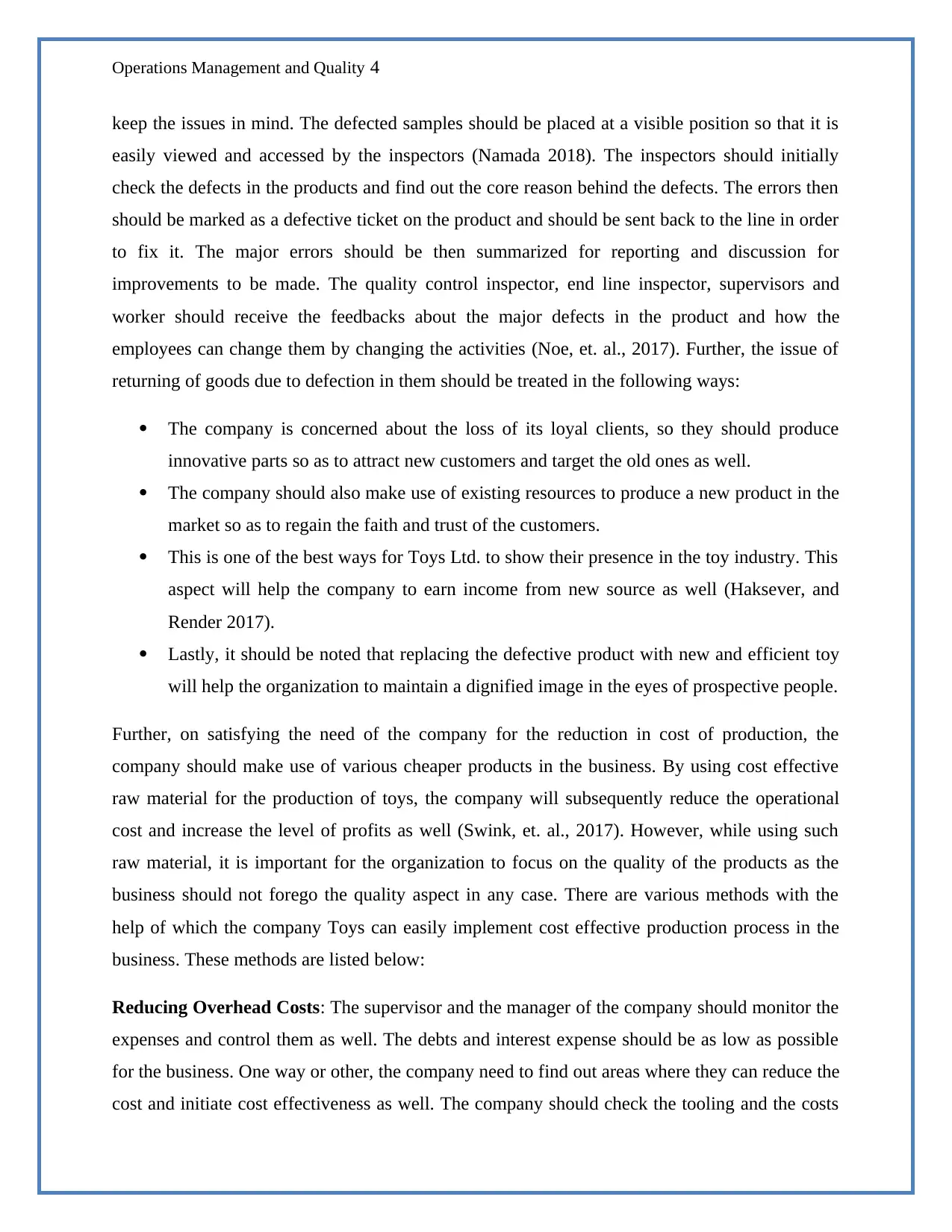
Operations Management and Quality 4
keep the issues in mind. The defected samples should be placed at a visible position so that it is
easily viewed and accessed by the inspectors (Namada 2018). The inspectors should initially
check the defects in the products and find out the core reason behind the defects. The errors then
should be marked as a defective ticket on the product and should be sent back to the line in order
to fix it. The major errors should be then summarized for reporting and discussion for
improvements to be made. The quality control inspector, end line inspector, supervisors and
worker should receive the feedbacks about the major defects in the product and how the
employees can change them by changing the activities (Noe, et. al., 2017). Further, the issue of
returning of goods due to defection in them should be treated in the following ways:
The company is concerned about the loss of its loyal clients, so they should produce
innovative parts so as to attract new customers and target the old ones as well.
The company should also make use of existing resources to produce a new product in the
market so as to regain the faith and trust of the customers.
This is one of the best ways for Toys Ltd. to show their presence in the toy industry. This
aspect will help the company to earn income from new source as well (Haksever, and
Render 2017).
Lastly, it should be noted that replacing the defective product with new and efficient toy
will help the organization to maintain a dignified image in the eyes of prospective people.
Further, on satisfying the need of the company for the reduction in cost of production, the
company should make use of various cheaper products in the business. By using cost effective
raw material for the production of toys, the company will subsequently reduce the operational
cost and increase the level of profits as well (Swink, et. al., 2017). However, while using such
raw material, it is important for the organization to focus on the quality of the products as the
business should not forego the quality aspect in any case. There are various methods with the
help of which the company Toys can easily implement cost effective production process in the
business. These methods are listed below:
Reducing Overhead Costs: The supervisor and the manager of the company should monitor the
expenses and control them as well. The debts and interest expense should be as low as possible
for the business. One way or other, the company need to find out areas where they can reduce the
cost and initiate cost effectiveness as well. The company should check the tooling and the costs
keep the issues in mind. The defected samples should be placed at a visible position so that it is
easily viewed and accessed by the inspectors (Namada 2018). The inspectors should initially
check the defects in the products and find out the core reason behind the defects. The errors then
should be marked as a defective ticket on the product and should be sent back to the line in order
to fix it. The major errors should be then summarized for reporting and discussion for
improvements to be made. The quality control inspector, end line inspector, supervisors and
worker should receive the feedbacks about the major defects in the product and how the
employees can change them by changing the activities (Noe, et. al., 2017). Further, the issue of
returning of goods due to defection in them should be treated in the following ways:
The company is concerned about the loss of its loyal clients, so they should produce
innovative parts so as to attract new customers and target the old ones as well.
The company should also make use of existing resources to produce a new product in the
market so as to regain the faith and trust of the customers.
This is one of the best ways for Toys Ltd. to show their presence in the toy industry. This
aspect will help the company to earn income from new source as well (Haksever, and
Render 2017).
Lastly, it should be noted that replacing the defective product with new and efficient toy
will help the organization to maintain a dignified image in the eyes of prospective people.
Further, on satisfying the need of the company for the reduction in cost of production, the
company should make use of various cheaper products in the business. By using cost effective
raw material for the production of toys, the company will subsequently reduce the operational
cost and increase the level of profits as well (Swink, et. al., 2017). However, while using such
raw material, it is important for the organization to focus on the quality of the products as the
business should not forego the quality aspect in any case. There are various methods with the
help of which the company Toys can easily implement cost effective production process in the
business. These methods are listed below:
Reducing Overhead Costs: The supervisor and the manager of the company should monitor the
expenses and control them as well. The debts and interest expense should be as low as possible
for the business. One way or other, the company need to find out areas where they can reduce the
cost and initiate cost effectiveness as well. The company should check the tooling and the costs
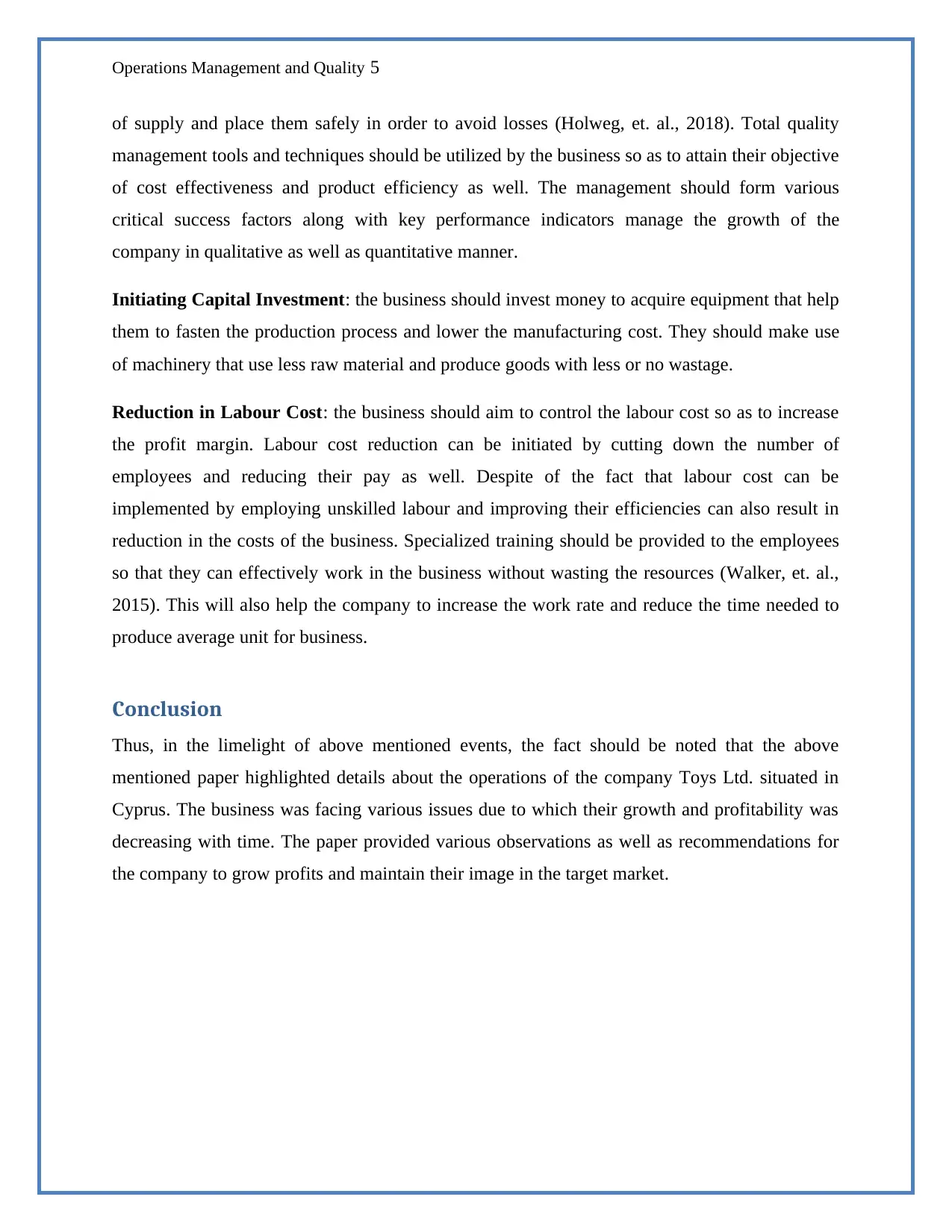
Operations Management and Quality 5
of supply and place them safely in order to avoid losses (Holweg, et. al., 2018). Total quality
management tools and techniques should be utilized by the business so as to attain their objective
of cost effectiveness and product efficiency as well. The management should form various
critical success factors along with key performance indicators manage the growth of the
company in qualitative as well as quantitative manner.
Initiating Capital Investment: the business should invest money to acquire equipment that help
them to fasten the production process and lower the manufacturing cost. They should make use
of machinery that use less raw material and produce goods with less or no wastage.
Reduction in Labour Cost: the business should aim to control the labour cost so as to increase
the profit margin. Labour cost reduction can be initiated by cutting down the number of
employees and reducing their pay as well. Despite of the fact that labour cost can be
implemented by employing unskilled labour and improving their efficiencies can also result in
reduction in the costs of the business. Specialized training should be provided to the employees
so that they can effectively work in the business without wasting the resources (Walker, et. al.,
2015). This will also help the company to increase the work rate and reduce the time needed to
produce average unit for business.
Conclusion
Thus, in the limelight of above mentioned events, the fact should be noted that the above
mentioned paper highlighted details about the operations of the company Toys Ltd. situated in
Cyprus. The business was facing various issues due to which their growth and profitability was
decreasing with time. The paper provided various observations as well as recommendations for
the company to grow profits and maintain their image in the target market.
of supply and place them safely in order to avoid losses (Holweg, et. al., 2018). Total quality
management tools and techniques should be utilized by the business so as to attain their objective
of cost effectiveness and product efficiency as well. The management should form various
critical success factors along with key performance indicators manage the growth of the
company in qualitative as well as quantitative manner.
Initiating Capital Investment: the business should invest money to acquire equipment that help
them to fasten the production process and lower the manufacturing cost. They should make use
of machinery that use less raw material and produce goods with less or no wastage.
Reduction in Labour Cost: the business should aim to control the labour cost so as to increase
the profit margin. Labour cost reduction can be initiated by cutting down the number of
employees and reducing their pay as well. Despite of the fact that labour cost can be
implemented by employing unskilled labour and improving their efficiencies can also result in
reduction in the costs of the business. Specialized training should be provided to the employees
so that they can effectively work in the business without wasting the resources (Walker, et. al.,
2015). This will also help the company to increase the work rate and reduce the time needed to
produce average unit for business.
Conclusion
Thus, in the limelight of above mentioned events, the fact should be noted that the above
mentioned paper highlighted details about the operations of the company Toys Ltd. situated in
Cyprus. The business was facing various issues due to which their growth and profitability was
decreasing with time. The paper provided various observations as well as recommendations for
the company to grow profits and maintain their image in the target market.
⊘ This is a preview!⊘
Do you want full access?
Subscribe today to unlock all pages.

Trusted by 1+ million students worldwide
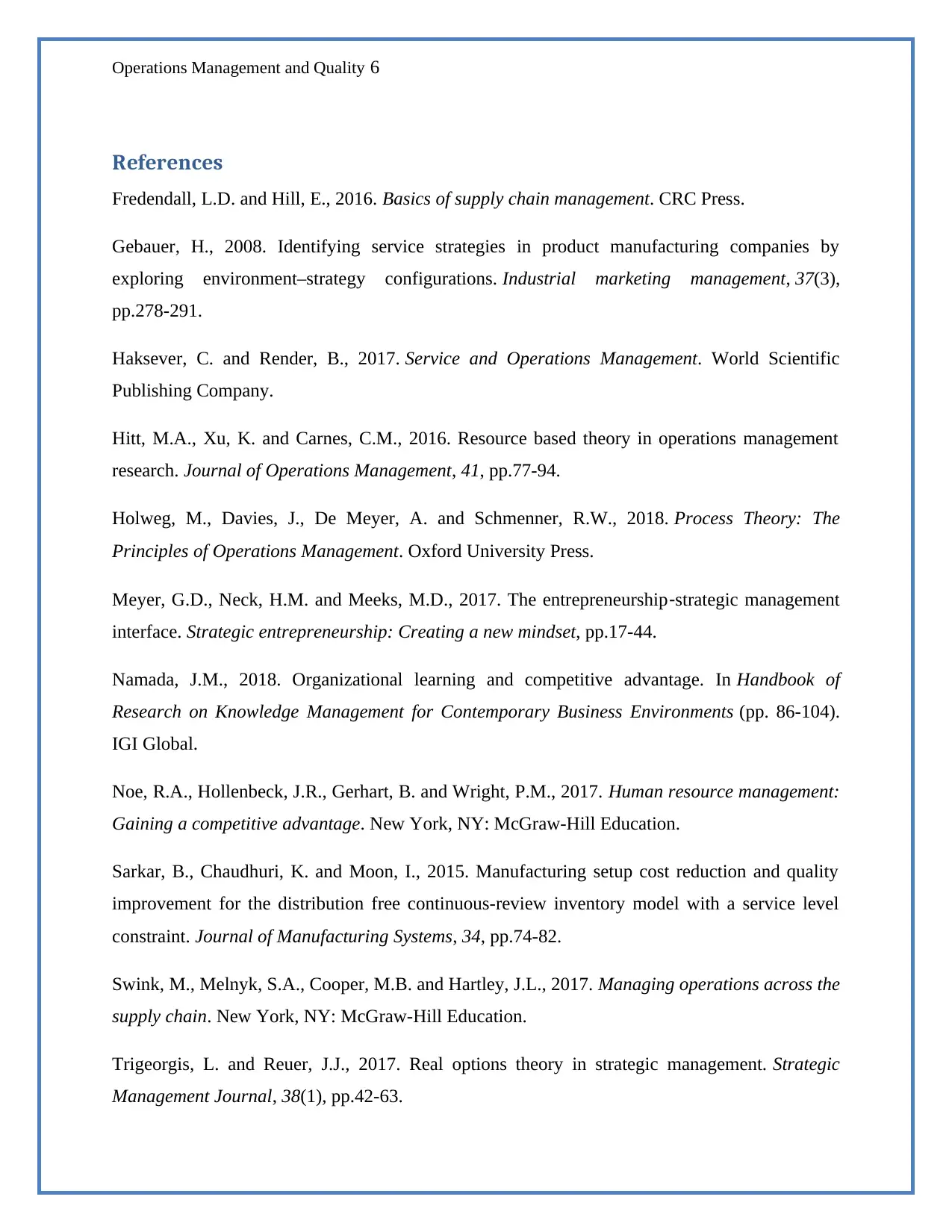
Operations Management and Quality 6
References
Fredendall, L.D. and Hill, E., 2016. Basics of supply chain management. CRC Press.
Gebauer, H., 2008. Identifying service strategies in product manufacturing companies by
exploring environment–strategy configurations. Industrial marketing management, 37(3),
pp.278-291.
Haksever, C. and Render, B., 2017. Service and Operations Management. World Scientific
Publishing Company.
Hitt, M.A., Xu, K. and Carnes, C.M., 2016. Resource based theory in operations management
research. Journal of Operations Management, 41, pp.77-94.
Holweg, M., Davies, J., De Meyer, A. and Schmenner, R.W., 2018. Process Theory: The
Principles of Operations Management. Oxford University Press.
Meyer, G.D., Neck, H.M. and Meeks, M.D., 2017. The entrepreneurship‐strategic management
interface. Strategic entrepreneurship: Creating a new mindset, pp.17-44.
Namada, J.M., 2018. Organizational learning and competitive advantage. In Handbook of
Research on Knowledge Management for Contemporary Business Environments (pp. 86-104).
IGI Global.
Noe, R.A., Hollenbeck, J.R., Gerhart, B. and Wright, P.M., 2017. Human resource management:
Gaining a competitive advantage. New York, NY: McGraw-Hill Education.
Sarkar, B., Chaudhuri, K. and Moon, I., 2015. Manufacturing setup cost reduction and quality
improvement for the distribution free continuous-review inventory model with a service level
constraint. Journal of Manufacturing Systems, 34, pp.74-82.
Swink, M., Melnyk, S.A., Cooper, M.B. and Hartley, J.L., 2017. Managing operations across the
supply chain. New York, NY: McGraw-Hill Education.
Trigeorgis, L. and Reuer, J.J., 2017. Real options theory in strategic management. Strategic
Management Journal, 38(1), pp.42-63.
References
Fredendall, L.D. and Hill, E., 2016. Basics of supply chain management. CRC Press.
Gebauer, H., 2008. Identifying service strategies in product manufacturing companies by
exploring environment–strategy configurations. Industrial marketing management, 37(3),
pp.278-291.
Haksever, C. and Render, B., 2017. Service and Operations Management. World Scientific
Publishing Company.
Hitt, M.A., Xu, K. and Carnes, C.M., 2016. Resource based theory in operations management
research. Journal of Operations Management, 41, pp.77-94.
Holweg, M., Davies, J., De Meyer, A. and Schmenner, R.W., 2018. Process Theory: The
Principles of Operations Management. Oxford University Press.
Meyer, G.D., Neck, H.M. and Meeks, M.D., 2017. The entrepreneurship‐strategic management
interface. Strategic entrepreneurship: Creating a new mindset, pp.17-44.
Namada, J.M., 2018. Organizational learning and competitive advantage. In Handbook of
Research on Knowledge Management for Contemporary Business Environments (pp. 86-104).
IGI Global.
Noe, R.A., Hollenbeck, J.R., Gerhart, B. and Wright, P.M., 2017. Human resource management:
Gaining a competitive advantage. New York, NY: McGraw-Hill Education.
Sarkar, B., Chaudhuri, K. and Moon, I., 2015. Manufacturing setup cost reduction and quality
improvement for the distribution free continuous-review inventory model with a service level
constraint. Journal of Manufacturing Systems, 34, pp.74-82.
Swink, M., Melnyk, S.A., Cooper, M.B. and Hartley, J.L., 2017. Managing operations across the
supply chain. New York, NY: McGraw-Hill Education.
Trigeorgis, L. and Reuer, J.J., 2017. Real options theory in strategic management. Strategic
Management Journal, 38(1), pp.42-63.
Paraphrase This Document
Need a fresh take? Get an instant paraphrase of this document with our AI Paraphraser
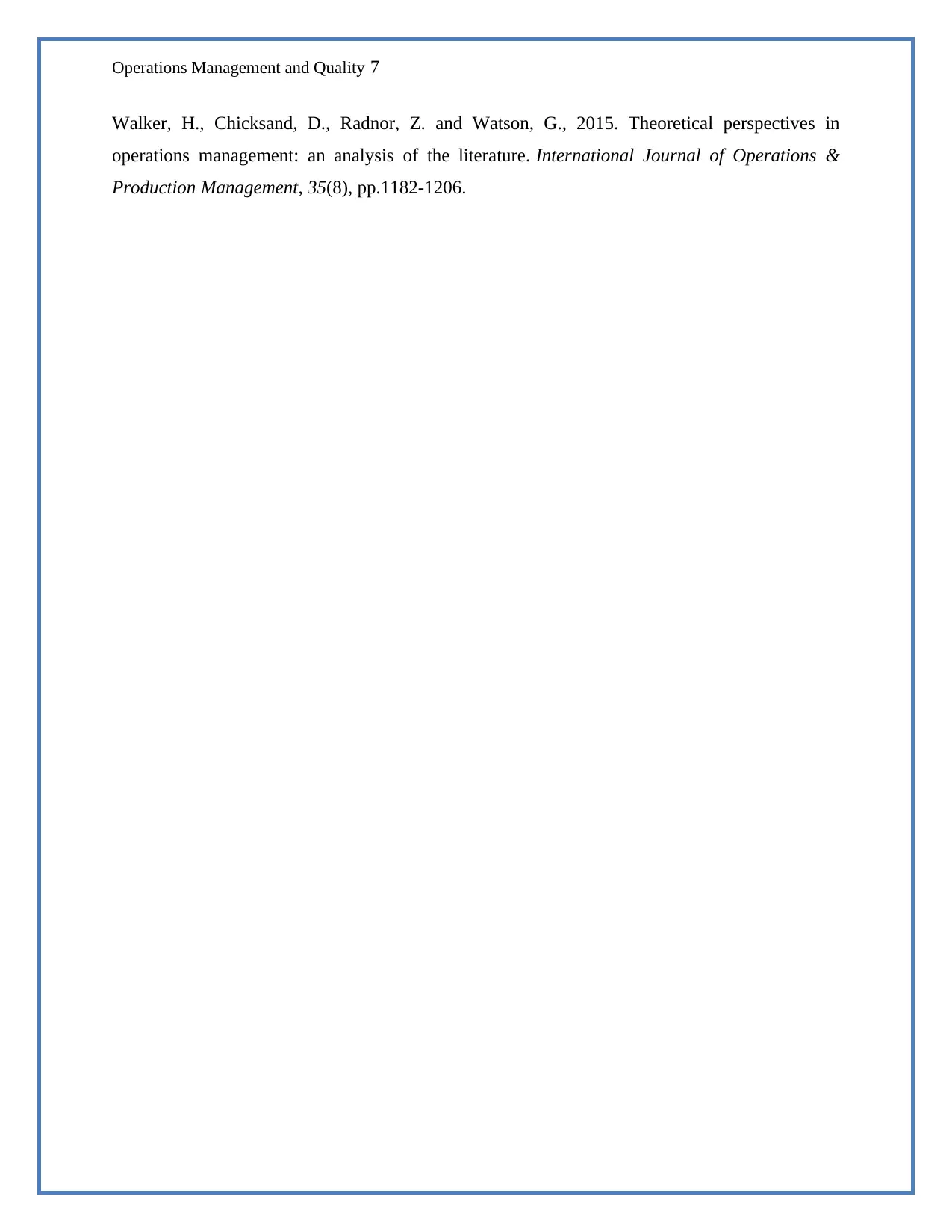
Operations Management and Quality 7
Walker, H., Chicksand, D., Radnor, Z. and Watson, G., 2015. Theoretical perspectives in
operations management: an analysis of the literature. International Journal of Operations &
Production Management, 35(8), pp.1182-1206.
Walker, H., Chicksand, D., Radnor, Z. and Watson, G., 2015. Theoretical perspectives in
operations management: an analysis of the literature. International Journal of Operations &
Production Management, 35(8), pp.1182-1206.
1 out of 8
Related Documents
Your All-in-One AI-Powered Toolkit for Academic Success.
+13062052269
info@desklib.com
Available 24*7 on WhatsApp / Email
![[object Object]](/_next/static/media/star-bottom.7253800d.svg)
Unlock your academic potential
Copyright © 2020–2025 A2Z Services. All Rights Reserved. Developed and managed by ZUCOL.





